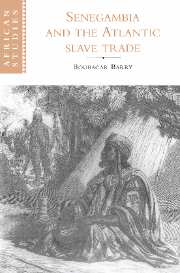Book contents
- Frontmatter
- Contents
- Preface
- Map
- I Senegambia from the fifteenth to the seventeenth century: a haven for incoming populations, a station for migrants on the move
- II Senegambia in the eighteenth century: the slave trade, ceddo regimes and Muslim revolutions
- III Senegambia in the first half of the nineteenth century: legitimate trade and sovereignty disputes
- 9 The crisis of the trans-Atlantic trading system and the triumph of legitimate trade in the first half of the nineteenth century
- 10 Popular rebellions and political and social crises in Futa Jallon
- 11 Futa Jallon expansion into the Southern Rivers region
- 12 The colony of Senegal and political and social crises in northern Senegambia
- 13 Defeat of the holy warriors in northern Senegambia
- IV Senegambia in the second half of the nineteenth century: colonial conquest and resistance movements
- Conclusion
- Notes
- Bibliography
- Index
- Other books in the series
11 - Futa Jallon expansion into the Southern Rivers region
Published online by Cambridge University Press: 31 October 2009
- Frontmatter
- Contents
- Preface
- Map
- I Senegambia from the fifteenth to the seventeenth century: a haven for incoming populations, a station for migrants on the move
- II Senegambia in the eighteenth century: the slave trade, ceddo regimes and Muslim revolutions
- III Senegambia in the first half of the nineteenth century: legitimate trade and sovereignty disputes
- 9 The crisis of the trans-Atlantic trading system and the triumph of legitimate trade in the first half of the nineteenth century
- 10 Popular rebellions and political and social crises in Futa Jallon
- 11 Futa Jallon expansion into the Southern Rivers region
- 12 The colony of Senegal and political and social crises in northern Senegambia
- 13 Defeat of the holy warriors in northern Senegambia
- IV Senegambia in the second half of the nineteenth century: colonial conquest and resistance movements
- Conclusion
- Notes
- Bibliography
- Index
- Other books in the series
Summary
The development of peanut farming enabled the Southern Rivers region to adjust gradually to the abolition of the slave trade. The growth of legitimate trade turned the coast into a magnet for traders from Futa Jallon, at a time when French, English, and Portuguese trading companies were also moving in, hoping to profit from new opportunities in the trans-Atlantic trading system.
Futa Jallon was already a power on the mainland. Now it mobilized all its forces for conquering the Southern Rivers market between the Gambia and Sierra Leone. It tightened its control over Rio Nunez and Rio Pongo, and undertook a vast military campaign against Kaabu and Forria, culminating in the famous battle of Kansala in 1867.
While Futa Jallon was seeking effective control over the Southern Rivers region, European trading companies in the area, notably the French firms, were struggling for monopoly control over peanut production. For a while, economic prosperity muted sovereignty disputes between European powers and the states of the Southern Rivers region. Meanwhile, attempts by new companies backed by metropolitan capital to gain commercial control had already aroused opposition from old slave-trading families. These made common cause with Futa Jallon, expecting to maintain the economic advantages they drew from contraband slave trading. At the same time, the local aristocracies were trying to use the new boom in legitimate trade as leverage in their efforts to challenge Futa Jallon suzerainty in the Southern Rivers region.
- Type
- Chapter
- Information
- Senegambia and the Atlantic Slave Trade , pp. 158 - 176Publisher: Cambridge University PressPrint publication year: 1997

